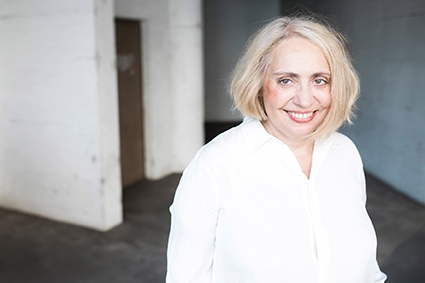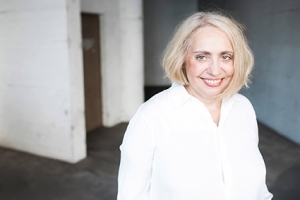Degot on the Steirischer Herbst Festival & Georgian Artists
Exclusive Interview
„What we call art now is mostly a 19th-century classical museum concept,” Ekaterina Degot, art historian, writer, and curator, tells us in an exclusive interview, “but in reality, art is an enormous field with a lot of directions: everything from post-modern to pre-modern or indigenous forms. This variety shows that art is based on the very deep human desire to produce something that does not have a utilitarian function, while at the same time being necessary for the understanding of human nature and the world. This desire is very old – and it persists now.”
steirischer herbst (meaning Styrian Autumn), one of Europe’s oldest interdisciplinary festivals of contemporary art, takes place in Graz (Austria) annually every autumn. Through art, the festival addresses the political and social issues of the local and international community. steirischer herbst ’19 is particularly interesting to Georgia as two Georgian artists, Guram Matskhonashvili and Giorgi Gago Gagoshidze, are to exhibit there.
Last year, the festival got a new director, the Russian curator and scholar Ekaterina Degot. While visiting Tbilisi, Degot talked to GEORGIA TODAY about the festival, the challenges of contemporary art, the Georgian artists involved and Tbilisi, the city that - as she claims – ‘has kept its soul’.
We ask her what got her into the field.
“Well, everybody tries to work with what they are passionate about and I’ve always loved art. Growing up in the Soviet Union, I was not allowed to travel abroad and by studying art history, I felt like I was traveling the globe. I think that played a big role in my interest.”
Some of your earlier work, like the exhibition of underwear in Soviet times, could be described as a protest. Do you believe that art should serve the state in the form of social activism? Are you an activist?
All art is political. The work of a curator, too, is always political and aims for the changes in society. Being an activist means one does not trust existing institutions; that one wants to intervene in the political field directly, which in some countries can be very dangerous. Russia is a notable current example of this. I do not consider myself an activist curator in Austria, although some of the artists I exhibit could be called activists. Nevertheless, I am definitely a very consciously political curator.
Tell us about the steirischer herbst festival. What is its aim?
It started in 1968 in Graz, an Austrian city located close to theborder with the Soviet Block, quite far removed from the big centers of European culture at the time. Former Nazis were still in power as educators at Austrian universities. Avant-garde artists were feeling very lonely in a hostile environment and this defined the energy that led to the creation of the festival as aconfrontation with conservative society. At the same time, of course, festivals like steirischer herbst have to win society over, so there is a goal to make a big social impact. steirischer herbst mainly consists of visual art, but the festival also includes literature, theater, music, and lots of discursive events. Through art, we want to open political and social debate.
This is your second year curating the festival. How would you describe your experience? What were the biggest challenges?
The festival is working in a site-specific way, which means that each year we have to find spaces in Graz and the region of Styria that would help us to tell the story we want. At the same time they have to be suitable in a practical sense. It needs to be a place with a great story that resonates with global contexts, whilst also inspiring the artist we invite. This is, of course, challenging, but at the same time it is what brings us the most interesting and rewarding results. Installations in former shops,theater productions in churches, and so on.
Last year the festival was about new soft fascism, this year it is about hedonism in the time of crisis. How are these ‘little fascisms’ relevant in today’s society?
Unfortunately, all over the world, conservatism is on the rise. It has different forms, different faces. In Austria, like in many – especially Eastern-European – countries, such as nearby Hungary, the right-wing party is openly nationalist, xenophobic and often evokes the Nazi past. This is the reality we are working in.
This year’s theme is ‘the Grand Hotel Abyss.’ Why did you choose this metaphor by Georg Lukács?
Enjoying the pleasures ‘the good life’, while the world finds itself on the verges of crisis, is an experience we are all familiar with. These days, we are even obliged to pursue enjoyment, dutifully sharing our pleasurable experiences via social media. This is happening, however, against a backdrop of increasinglyalarming political news. The city of Graz also serves as an inspiration: the city’s counter-Reformation baroque architecture itself is a sort of propaganda of enjoyment, and the contemporary touristic identity of Graz unmistakably insists on culinary and cultural pleasures. We were intrigued by this identity and explored the implications of such hedonism in different historical contexts.
The metaphor consists of two concepts: the hotel of pleasure and the abyss outside of it. In today’s world, what would you say is the Grand Hotel and what is the Abyss?
The hotel is life in Europe. Europe enjoys the fortress that it has built. A fortress that does not let outsiders in, and propagates the pleasures of its lifestyle in the press and on social media. This is actually a pretty new trend in European culture: the continenthad its periods of hedonism before, but was typically reluctant to boast about it. This new development might be the result of American influences combined with an exposure to consumer culture.
In Europe – well, in Austria and Russia, at least – you are supposed to complain. It’s impolite to say you are doing well. However, we are experiencing an increasing pressure to be happy, possibly enhanced by the feeling that our civilization is coming to an end.
The abyss is the future of our civilization – one that is very much under question, ecologically but even more so politically. I would say very few people have an optimistic view of our future. Most people can’t help but feel that the world is going in the wrong direction.
What brings you to Tbilisi?
I’m here to see the rehearsals for the play which will premiere atthe festival. The play that I commissioned is written by Keti Chukhrov, who is an important poet and philosopher living in London and Moscow. She wrote a satiric comedy titled Global Congress of Post-Prostitution, which takes place in Zugdidi. Itis about love and sex between the genders, but also between the West and the East. We are very happy that we have found a great, young and talented theater director to stage this play – Guram Matskhonashvili. I am here to get a glimpse of how the production is going.
We understand you were last here during the Soviet period. How would you say Tbilisi has changed?
Actually, it has probably changed less than Moscow. Tbilisi has kept its charm and soul. Everybody loves it and even though I’ve been here only two days, I’m totally in love with it too. I’m already making plans to come back and go to other places in Georgia. The Tbilisi landscape is very picturesque, but I feel that it is mostly the human relations that make Tbilisi unique. I haven’t been here long, and it would be presumptuous of me to propose any final conclusions, but I think that even the architecture of Tbilisi shows how social and supportive the city and its habitants can be.
There are two Georgian artists involved in the steirischer herbst ’19. How did they end up participating?
Keti wanted a Georgian artist to direct the play. The other artist, Giorgi Gago Gagoshidze, I came across, accidentally. The film he has made fits perfectly with the theme of the exhibition. He’s directed a very beautiful film about his father. I found the humor of the movie very moving – he compares the hand his father lost as a seasonal worker in Europe to the "invisible hand of the market". I see a great artistic potential here in Georgia, andwould definitely like to work with Georgian artists more.
What would you say is the biggest challenge for artists today?
As always, the challenge is to say something meaningful about the world we live in, to be a truthful mirror to society, like realists would say. But the biggest challenge for an artist is to be heard and seen, as this mirror he or she offers is not always welcomed.
The curatorial concept of the festival reads: “Many of the contributions to steirischer herbst engage with apocalyptic imaginary, not only as a mirror of dystopian tendencies in the present but as a space for hope and renewal.” What is this hope and what renewal should we hope for?
Traditionally, visual artists based on the avant-garde traditionlike negativity, absence, void and destruction. They feel very comfortable in catastrophic situations because they see them as a great environment in which to make art. For them, theapocalypse is a form of revolution, too. Revolution is the moment when things turn upside down, and new possibilities emerge. In this sense, one could look at the apocalypse as a hopeful and idealistic opportunity to break with the predicaments of our current epoch.
By Nini Dakhundaridze











